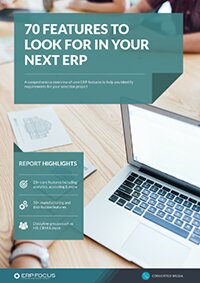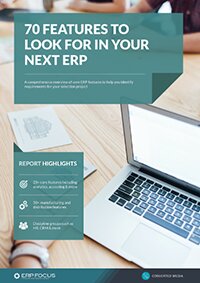Mobile ERP case studies you can learn from
As the saying goes, “for every seller, there’s a buyer,” or in our case, an enterprise resource planning platform. As businesses and consumers rely more on mobile technology, time spent on mobile devices keeps growing.
On average, adults in the US now spend nearly four hours a day on their phones, mainly using apps for communication, entertainment and work. This rise in mobile usage directly impacts how enterprise resource planning (ERP) systems are developed and adopted. Let’s explore how mobile ERP fits into this changing landscape.
What is mobile ERP?
First, let’s take a quick refresher on the meaning of what we refer to as today’s mobile ERP. To paraphrase IGI Global, mobile ERP extends traditional ERP tenets and processes by independently collecting and exchanging data via mobile devices and wireless communications mechanisms. Standardized interfaces allow a direct and steady connection to distributed ERP systems, leading to more flexible and efficient enterprise business processing.
In more simple terms, mobile ERP solutions can be explained as virtual ‘all-the-time-anywhere’ operating platforms that can be leveraged by managers, workers, or customers in real time. This universal value proposition allows the enterprise to force-multiply any scale of enterprise; whether it’s a small ‘Mom and Pop’ shop generating revenues on the order of a million dollars or less, or a multinational industry titan generating billions on an annual basis.
Mobile ERP accessibility: What does it mean for your business?
As businesses increasingly adopt mobile ERP solutions, one of the key benefits they offer is enhanced mobile ERP accessibility. This refers to the ability of employees, managers, and other stakeholders to access critical enterprise data and tools from anywhere, at any time, using their mobile devices. Whether in the field, traveling, or working remotely, employees can stay connected to the ERP system, ensuring continuous workflow and faster decision-making.
Use our free ERP selection checklist to find the right software for your organization
Mobile ERP accessibility eliminates the need to wait until you’re back at the office to update customer records, check inventory, or review sales reports. Instead, all essential processes, from supply chain management to financial reporting, can be done on the go, offering businesses real-time visibility and operational flexibility.
The importance of mobile ERP software for remote workforces
Given the rise of remote and hybrid work environments, mobile ERP software plays a vital role in keeping teams productive, no matter where they are. Remote employees can easily log into the system, process approvals, view project updates, and even collaborate with colleagues across different time zones.
For industries such as construction, field service, and logistics, where on-site data entry and real-time updates are crucial, mobile ERP ensures that no delay occurs in critical business functions.
In fact, recent data shows that over 50% of US remote-capable employees expect and prefer hybrid work models, highlighting the growing importance of flexible, mobile-enabled solutions that support remote workforces.
Mobile ERP security considerations
One of the major concerns with mobile ERP is security. With data being accessed from multiple devices and locations, it's essential to implement strict security measures to safeguard sensitive business information. This includes robust encryption, multi-factor authentication, and regular security updates to ensure compliance with industry standards.
For example, oil and gas industries often need to secure real-time data related to drilling operations, which could otherwise be vulnerable to breaches if mobile ERP security isn't up to date. Mobile ERP software ensures that enterprises maintain the highest level of data security, protecting critical business functions from potential cyber threats.
Industry-specific mobile ERP apps
Today’s constellation of mobile apps ranges from the simple to the complex. Nevertheless, all offerings suggest the same business values; enhanced production and the promise of consequent increased revenues. To understand this assertion it is best left to the market itself, so let’s take a look at a couple of mobility-adept industries and their common functions/features applicable to today’s market.
- Manufacturing – this category ranges from small fabrication operations to large-scale product developers such as auto or equipment brands. Particular functions and features typically involve all record adds/changes/deletes, time/stamp markers, geo-locators, user announcements, and security alarms.
- Commercial marine operations – this category primarily relates to vessel processes and dock and port facilities. Particular functions and features typically involve all record adds/changes/deletes, time/stamp markers, navigational tracking, communication systems status’, geo-locators, standard/emergency user announcements, and triggered security alarms.
- Oil and gas development – this category primarily relates to drilling, refining, production and delivery of fossil fuels. Particular functions and features typically involve all record adds/changes/deletes, time/stamp markers, geo-locators, standard/emergency safety announcements, and HAZMAT, and/or triggered security alarms.
As suggested earlier, these mobile ERP features apply to three industrial segments and represent only a small sampling of what mobility means to today’s global industry.
Compare the features and functions of ERP systems with our free ERP software comparison tool
Mobile ERP case studies
Here are some case examples to review as you determine how important mobile ERP is to your own business needs. These case samples range from mid to large-scale operations, however, all enterprises were either already involved with a current ERP platform or were applying active mobile capabilities during various selection/launch/implementation processes.
1. Transportation supply-chain operator
The company is a leading supply-chain operator in the road construction equipment segment. The company is a mature enterprise, encompassing a 40-year lifespan. Its product line is extensive, primarily supporting global transportation systems developers.
The mobility requirement
The company’s workforce expanded in recent years, requiring a need to streamline its administrative communications capabilities. It aimed to ensure that all information related to personnel allotments and task assignments were deliverable throughout the company’s business infrastructure. The company also wanted to enhance field staff operations by equipping them with a native mobility capability oriented to enhanced customer support and affiliated reporting.
Baseline scenario
The administrative manager usually assigns sales staff to field sales managers, who then manage multiple customers. Previously, paper forms were used after each sales transaction to gather information, followed by manual data entry through the company's web portal. As the company expanded, operational logjams developed due to the growing number of active customers.
Subsequently, a related internal investigation found that:
- Sales personnel spent too much time searching for necessary customer information.
- Manual data entry processes were redundant and prone to error.
- Sales status reports experienced delivery lags since legacy processes only allowed for end-of-day batching.
- New customer record updates were slow and consequently resulted in lost sales.
The company’s solution
The company already had a web application system, so after a thorough internal analysis, it proposed an iPad app for its field staff. The app enabled the company to seamlessly use its online portal and active data store.
It offered various record options, including customer lists, address books, and an ability to register operational events, while using direct geo-location. The app also allowed sales personnel to submit reports in real time.
Results
After development and implementation were concluded, the company successfully realized all stated goals.
2. Mid-size retail sales chain
Various metrics relating to today’s retail environment suggest that a minimum of 50% of all retail customers involve themselves with smartphone device use. This non-mobile mid-size retail operator found itself facing increasing competition from other mobile-enabled competitors.
The mobility requirement
The company was not mobile-enabled and consequently was experiencing lost sales opportunities, particularly in the case of targeting young customers. Unfortunately, the company had largely depended on young users to increase brand value through word-of-mouth.
Baseline scenario
The company required a way to enhance its promotion, marketing, and engagement of products to young customers, while at the same time leveraging a seamless resources-based digital infrastructure. The company felt that by tailoring its sales offerings while enhancing the company’s shopping experience, customers would be more attentive to its product attractions.
The company’s solution
The company engaged a professional mobile developer to ensure that a proper set of operational goals were established. Subsequently, the following solutions were developed and delivered to the company:
- Mobile shopping cart – allowed users to select and purchase items on demand.
- Mobile product search – enabled targeted lookups of specific items from larger catalog products.
- Mobile payment – enabled customers to securely pay for purchases.
- Mobile product ship and track – enabled customers to manage inbound products and allowed the company to maintain active transaction tracking.
- Wish list– allowed users to bookmark selected items for future purchase.
- Store locator– helped customers find the nearest outlet.
- Direct support – provided customers access to a 24/7 hotline with live chat.
Results
Once the company launched its mobile app it reported a significant rise in customer engagement. Customer ease of access led to numerous positive responses from its sales team. Ultimately, customer retention has risen accordingly, in addition to significant increases in new prospect transactions.
Case studies 1 and 2 were originally sourced from Innomobile, but their respective pages have since been removed.
3. Global aviation manufacturer
While the company’s outsourced operations lowered manufacturing costs, it also added complexity and presented a need for rigid controls when managing day-to-day operations. Due to the limitations of a legacy MRP system, and while establishing a newly sophisticated multiple-module ERP platform, much of the company’s work had to be done manually, which became increasingly more difficult to manage as the company grew. Consequently, a mobility-adept system was desired as a middle ground.
Baseline scenario
To prevent counterfeit items from entering its supply chain, the company bought a significant number of parts domestically and consigned them to factories in China.
The practice required manual calculations of needed components based on finished assembly usage and inventory levels at the factory. Additionally, the company had to calculate the necessary excess to purchase based on historic scrap levels. Communicating with Hong Kong and China operations was also challenging due to time differences.
The Solution
The company implemented a multi-module ERP system, including accounting, purchasing, sales orders, and inventory, enhanced with mobile capabilities. Once complete, critical data was shared across the company’s functional areas in real time, and the ERP system provided real-time visibility into inventory levels at its four factories in China. A quality module was also included to help the company meet international compliance standards.
The Results
The company’s ROI increased by 50% of sales growth by year four.
Source: IQMS
Mobile ERP in industry-specific scenarios: The future of on-the-go management
The next frontier for mobile ERP software lies in its adaptability to unique industry requirements. Imagine a future where mobile ERP solutions integrate with technologies like AI and IoT (Internet of Things) to adjust production schedules, predict equipment failures, or reallocate resources on the fly.
For industries like oil and gas, where safety and efficiency are paramount, the ability to receive real-time HAZMAT alerts and equipment updates through mobile ERP systems can save millions in downtime and prevent potential disasters.
Final thoughts: How mobile ERP fits into your business
After looking at these examples, it's clear that mobile ERP software has a lot to offer, no matter what industry you're in. It helps streamline everyday tasks, improves communication between teams, and gives you more flexibility to work wherever you are.
If your business involves field workers, remote teams, or complex supply chains, mobile ERP could be the tool that helps you stay organized and efficient. It's about making sure everyone has the information they need when they need it. If you've been considering ERP solutions, it might be time to think about how mobile ERP can help your business stay agile and responsive.
Free white paper

70 features to look for in your next ERP
A comprehensive guide to help you identify requirements for your ERP selection

Featured white papers
Related articles
-

5 ERP pricing definitions you need to understand
Have you mastered the ERP pricing lexicon yet? Getting to grips with these five definitions is a ...
-

CMMC Compliance: What Aerospace and Defense Manufacturers Need to Know
Key insights on CMMC compliance, deadlines, and securing DoD contracts with CMMC 2.0 certificatio...
-

Calculating ERP implementation costs of top ERP systems
Where your ERP implementation budget should be allocated, and pricing models of top ERP



